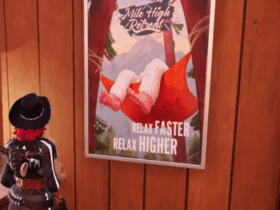I’m not sure I’ve ever played a game with such a panic-induced toilet scene. To a T begins with the young player character waking up in the morning before school and, first things first, needs to use the bathroom. Cue alarm bells, a sprint, and some awkward door opening before sweet relief accompanied by an orchestral chime.
In To a T, even the most everyday events are awkward. That’s because the protagonist – a young teen created by the player – is stuck in a T-pose, arms constantly spread out wide. It’s obviously a bit of a joke on the sort of character bug you might see in Skyrim, but there’s a deeper, more serious message here about disability too.
I played a short demo of To a T at this year’s Game Developers Conference, which was effectively a ‘day in the life’ of the young protagonist as they wake up and head to school. Yet in a T-pose, even the mundane is turned into a quest – as the trailer’s song goes, “the little things are hard for me”. Simple actions like cleaning teeth, eating breakfast, and choosing clothes are far from easy – each control stick becomes an arm as you tip a box of cereal carefully into a bowl before slowly but surely easing the spoon towards your mouth. It brings to mind something like Octodad and its awkward controls, but here underpinned by sincerity beyond its humour.
Thankfully, the teen is aided by one of the most adorable video game dogs I’ve seen. A little white ball of fluff with a lolling tongue, waddling walk and beady eyes, the dog is able to help squeeze toothpaste onto a toothbrush or grab clothes from the wardrobe – truly man’s best friend. A later episode involving dog poop was not only hilarious, it hinted at a super-powered narrative development.
Until then, the teen struggles on, but it’s all presented with such charm and sensitivity. The game comes from Katamari Damacy creator Keita Takahashi, now developing from Uvula, the indie studio he co-founded in 2010 with his wife, with Annapurna on publishing duties. As such, To a T has a familiar bizarre and colourful tone that’s bursting with joy. Though thought-provoking, it’s a celebration of disability.
Oh, and if the trailer wasn’t already clear, it’s a musical too. Not only is each song a cute bop, there’s a giraffe singing about making sandwiches. It’s great.

Interestingly enough, the link to disability wasn’t actually intended from the start. “The concept of the character being in a T-pose came from another small game idea I had,” Takahashi told me. “I hadn’t linked the T-pose to disability until someone pointed it out in feedback. I was more focused on daily life challenges, which could be categorised as disabilities, but the inspiration was primarily drawn from game design.”
Following that realisation, Takahashi has worked with accessibility charity AbleGamers to ensure the game is an authentic portrayal of disability. “We sent the initial storyboards to AbleGamers and received some comments,” he said. “They liked the concept of a teen using well modified tools, such as a long spoon or long toothbrush.”
In the original storyboard, Takahashi explained, the teen dunked their head into a sink of water to clean their face. “AbleGamers pointed out that seems unrealistic,” he said. “They suggested that they should have a better designed sink or faucet in the house like a longer spoon because the teen was in a T-pose since birth.”
As such, the teen is able to get by with some specially designed mechanisms – in the final game, the faucet turns 180 degrees to eject water upwards. It mimics the sort of customised solutions disabled people often require in daily life – for gaming too, as with Caleb Kraft’s The Controller Project making custom designs, as well as both Xbox and PlayStation allowing for at least some customisation in their accessibility controllers.

It’s all fun and games until the teen needs to leave for school, though. Here the tone shifts to fear and it quickly becomes clear they suffer from bullying by the other schoolchildren due to their condition. It’s a troublesome walk to the school gates where, in nightmarish fashion, the building itself turns into a giant evil face with a long tongue rolling out like an (un)welcome mat. We don’t see what occurs during the school day, but the implication is traumatic enough.
Still, between the musical numbers, the bright stylised visuals, and the cheerful humour, those darker moments are balanced with positivity with affecting results. And while the demo was short, it’s clear there are some surprising developments to come that will no doubt see the teen overcoming their disability in extraordinary ways.
Takahashi is humble about balancing the game’s extremes. “Joy, humour, and unpleasant problems always exist in our daily lives, and I just captured them carefully and put them in the game,” he said. When I asked what he wants people to take away from the game, he remained tight-lipped, which only emphasised to me that there are surprises in store.
fbq('init', '560747571485047');
fbq('track', 'PageView'); window.facebookPixelsDone = true;
window.dispatchEvent(new Event('BrockmanFacebookPixelsEnabled')); }
window.addEventListener('BrockmanTargetingCookiesAllowed', appendFacebookPixels);











Leave a Reply